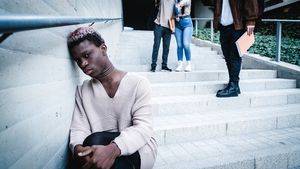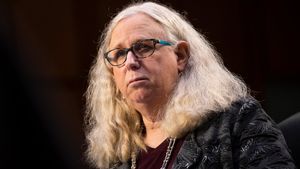Left: 'Untitled (Self-Portrait),1985.' Acrylic on canvas. Private collection. | Right: 'Untitled, 1982.' Vinyl paint on vinyl tarpaulin. Collection of Sloan and Roger Barnett (c) 2014, Keith Haring Foundation
Before he passed away of AIDS-related illnesses in 1990 at the age of 31, New York-based artist Keith Haring funneled his frustration with injustice into international fame. Making his mark through the use of illegal street art and subway drawings, wherein he would quickly fill in blank advertisement posters with vibrant, distinctive, immediately recognizable artwork in the brief time between when trains left and arrived at the station, his presence in New York was akin to that of a professional mass media campaign, spreading over much of the city's underground. Expanding his influence through the use of of sculptures, commissions for hospitals and charities, and large scale paintings, he has helped shape the face of major American cities such as San Francisco, where his work has been installed at the South of Market Childcare Center, the Moscone Convention Center, and the AIDS Chapel at Grace Cathedral. In 1989, he established the Keith Haring Foundation to generate AIDS activism and awareness. Now, San Francisco wishes to honor Haring for his achievements and highlight the oft-overlooked political nature of his work.
Opening at the de Young Fine Arts Museum in San Francisco November 8, Keith Haring: The Political Line features more than 130 works of art -- including large scale paintings, sculptures, and a number of the artist's subway drawings--and is the first time a major exhibit has focused on the political messages in his works so directly. "It is amazing that the question of social justice and change that Keith Haring devoted himself to has not been addressed before in a major exhibition," curator Dieter Buchhart stated in a press release, emphasizing the activist nature of Haring's work. "Haring understood that art was for everybody -- he fought for the individual and against dictatorship, racism and capitalism. He was no utopian, but he had a dream that 'nothing is an end, because it always can be the basis for something new and different.' "
Accompanying the exhibition is a catalog of the same title that seeks to explore the artist's work with politics, the urban landscape, and pop culture. The beautiful book features reproductions of over 200 of Haring's pieces, a photo gallery by his friends and photographer Tseng Kwong Chi, four essays on the political nature of Haring's art, and conversations with those close to the artist..
Keith Haring: The Political Line, Nov. 8-Feb. 16, 2015. San Francisco's de Young Museum of Fine Arts.












































































